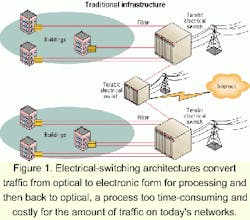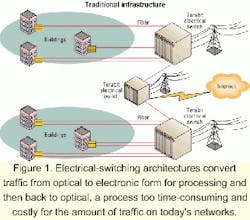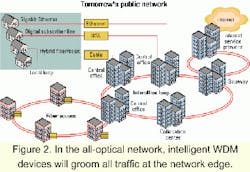Approaching the all-optical network
The evolution will require IP over intelligent WDM equipment at the network edge.
P.G. K. MENON, Atoga Systems
It's unanimous. All-optical switches will sit at the foundation in the infrastructure of the next-generation service provider. They're fast. They can be deployed quickly. They're simple to manage. And because of a variety of environmental considerations, all-optical switches are more suitable for building the optical Internet than electrical-switching architectures. All of these factors point to the emergence of all-optical switching in the metropolitan-network core, as service providers evolve their infrastructures to exploit the revenue opportunities of more sophisticated applications and services.
But for the full potential of this paradigm shift in optical networking to be realized, the network edge must also be re-addressed. The introduction of Internet Protocol (IP) over WDM at the network edge will be a critical step toward the all-optical network.
Despite the remarkable increase in Internet usage in the last five years, that growth rate will pale in comparison to the escalation expected over the next five years. We are only at the cusp of an era when businesses and consumers alike rely on the Internet as the primary medium over which to communicate rich and diverse content. Market researcher RHK Inc. (San Francisco) forecasts Internet traffic to skyrocket from 350,000 Tbytes per month in 1999 to 15 million Tbytes a month in 2003, a phenomenal growth rate of well over 4,000%.
The ubiquitous use of the Internet by businesses and consumers as a medium for communication and information exchange is at the heart of this growth. Multimedia, business-to-business-application traffic is playing no small role, and more and more, businesses are outsourcing their information hosting and content delivery functions to service providers. Responding to this trend, many carriers already offer broadband services for Internet access, information hosting, and intercity connectivity. In turn, regional network centers will offer similar services for metro access to their hosted applications.
Of course, it is clear that today's voice-centric public network is not nearly up to the challenge of the emerging needs of businesses and consumers. It is also becoming clear, though, that the availability of raw fiber will not be the problem.
The Federal Communications Commission has ordered the unbundling of fiber facilities owned by the regional Bell operating companies, and new fiber is being installed every day, adding to the 60 million km already deployed in the 200 top metropolitan areas of the United States.
What's more, the capacity of existing fiber plants is being multiplied as service providers implement WDM and DWDM platforms. Using WDM, a single strand of fiber that formerly carried only a single beam of traffic is transformed to act as a conduit for multiple wavelengths, each carrying additional traffic. But while WDM and DWDM unleash unprecedented amounts of bandwidth over optical fiber, the soaring processing demands on Internet routers continue to present a significant challenge for scaling bandwidth in a cost-effective manner.The primary reason today's public network cannot cost-effectively provide the performance and scalability that will be required for tomorrow's needs is the electrical-switching architectures that remain predominant. These traditional architectures back-haul traffic to electrical switches for processing information and determining routes to intended destinations (see Figure 1). Electrical switches rely on electrical signals for packet processing, while lightwaves are used in fiber-optic network transmission. Because of this disparity, traffic must be converted from optical to electronic form for processing and then back to optical before being sent along the network. This optical-to-electrical conversion is both costly and time-consuming. Consequently, the current infrastructure is rendered unsuitable for supporting the new speed-intensive applications that service providers intend to roll out for enterprises and consumers.
Furthermore, carriers have estimated that their capital and operating costs could be reduced by as much as 50% simply by eliminating the optical-to-electrical conversion that today must take place.
While fiber-optic networks can carry 10 to 40 Gbits/sec of traffic on a single link, meaningful electrical packet processing on that link is limited to between 1 and 2.5 Gbits/sec. All-optical switching eliminates this limitation.
However, it is not just because all-optical switches deliver greater capacity and reliability than their electrical ancestors that service providers are already sold on all-optical switches. As service providers position their networks for more sophisticated product offerings, these carriers are learning that the ongoing cost of ownership of all-optical switches is significantly lower than that of electrical architectures. All-optical switching is frictionless; because of that, no heat is generated in the process. Also, optical components and modules require less power to operate than do electrical architectures. And, in most cases, all-optic switches are smaller and therefore demand less valuable space in central offices and metropolitan data centers. That is certainly no small factor in carriers' enthusiasm for the new technologies.
The one drawback of optical switching is that all-optical systems have no memory. And a system without memory possesses only limited intelligence.
To optimize the performance of all-optical switches in the metro network core, devices at the edge must take on added responsibility. The edge of today's metro network is equipment-heavy. Separate boxes are required at each layer for connecting to the optical network. That entails considerable upfront equipment costs, in addition to significant ongoing maintenance expenses. There are operational issues with today's edge systems, as well. Provisioning is more complex than service providers would like, because each box must be configured individually.
No existing standards govern how provisioning requests are to be communicated among IP, SONET, and WDM devices. Equipment at the IP layer exchanges information with other IP equipment in the network, and equipment at the SONET layer exchanges information with other SONET equipment in the network. But there is no exchange of configuration information between IP equipment and SONET equipment. This communication gap forces the equipment at each layer to guess at traffic loads to be processed, and the fallout is gross inefficiency in service provisioning.
Intelligent edge devices can create new revenue opportunities for service providers. By integrating higher layers of intelligence in optical edge devices, customer traffic can be controlled using a wider array of network parameters. For example, time-of-day and traffic priority are among the most meaningful network parameters to customers. If service providers can control their network usage via these more relevant and billable parameters, they would be free to create new service offerings. And these new service offerings can open up new opportunities to create revenues.In place of today's legacy elements-largely derived from the existing worldwide telephony network-intelligent, integrated IP/SONET/WDM equipment offers a simple, flexible, and dynamic alternative. Intelligent WDM devices will groom all traffic at the network edge, unshackling all-optical switches in the core to simply switch wavelengths of light (see Figure 2). No processing will be required in the network core, reducing a service provider's operational costs and offering it opportunities for seamless network growth and scalability.
Eliminating the optical-to-electrical conversion that stagnates traffic in today's electrically switched public network and enabling lightwaves to travel without impediment promises to create new service-provider revenue opportunities and boost profitability. But for the vision of an all-optical network to crystallize, evolution must continue at the network edge as well as the network core.
All-optical core switches and integrated IP/SONET/WDM edge devices, working together to carry significantly more traffic over significantly greater distances at the speed of light, will be the critical enablers of tomorrow's public network.
P.G. K. Menon is vice president of marketing at Atoga Systems (Fremont, CA). He can be reached at the company's Website, http://www.atoga.com.


